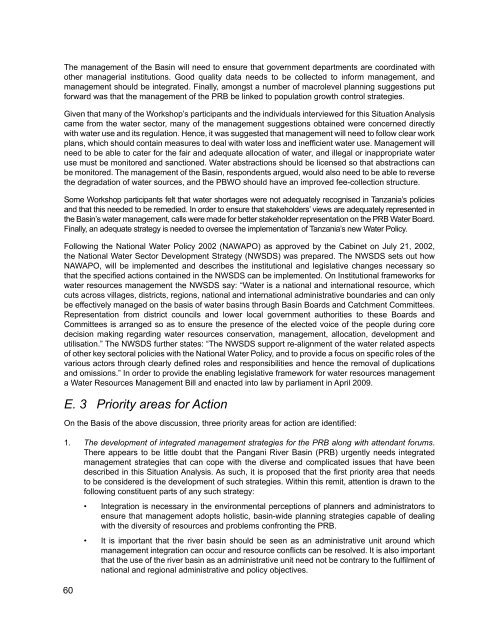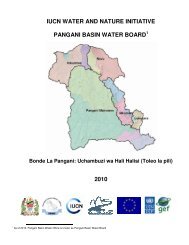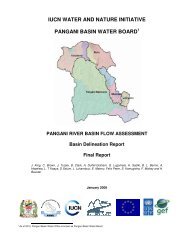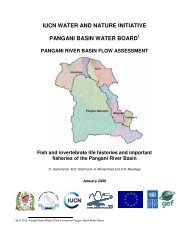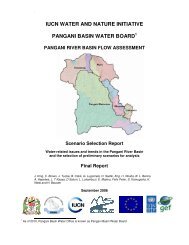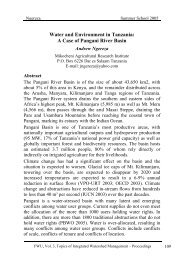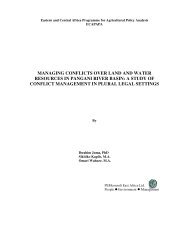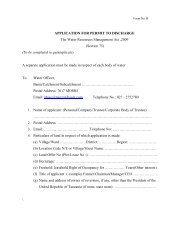PANGANI BASIN WATER BOARD
PANGANI BASIN WATER BOARD
PANGANI BASIN WATER BOARD
You also want an ePaper? Increase the reach of your titles
YUMPU automatically turns print PDFs into web optimized ePapers that Google loves.
The management of the Basin will need to ensure that government departments are coordinated with<br />
other managerial institutions. Good quality data needs to be collected to inform management, and<br />
management should be integrated. Finally, amongst a number of macrolevel planning suggestions put<br />
forward was that the management of the PRB be linked to population growth control strategies.<br />
Given that many of the Workshop’s participants and the individuals interviewed for this Situation Analysis<br />
came from the water sector, many of the management suggestions obtained were concerned directly<br />
with water use and its regulation. Hence, it was suggested that management will need to follow clear work<br />
plans, which should contain measures to deal with water loss and inefficient water use. Management will<br />
need to be able to cater for the fair and adequate allocation of water, and illegal or inappropriate water<br />
use must be monitored and sanctioned. Water abstractions should be licensed so that abstractions can<br />
be monitored. The management of the Basin, respondents argued, would also need to be able to reverse<br />
the degradation of water sources, and the PBWO should have an improved fee-collection structure.<br />
Some Workshop participants felt that water shortages were not adequately recognised in Tanzania’s policies<br />
and that this needed to be remedied. In order to ensure that stakeholders’ views are adequately represented in<br />
the Basin’s water management, calls were made for better stakeholder representation on the PRB Water Board.<br />
Finally, an adequate strategy is needed to oversee the implementation of Tanzania’s new Water Policy.<br />
Following the National Water Policy 2002 (NAWAPO) as approved by the Cabinet on July 21, 2002,<br />
the National Water Sector Development Strategy (NWSDS) was prepared. The NWSDS sets out how<br />
NAWAPO, will be implemented and describes the institutional and legislative changes necessary so<br />
that the specified actions contained in the NWSDS can be implemented. On Institutional frameworks for<br />
water resources management the NWSDS say: “Water is a national and international resource, which<br />
cuts across villages, districts, regions, national and international administrative boundaries and can only<br />
be effectively managed on the basis of water basins through Basin Boards and Catchment Committees.<br />
Representation from district councils and lower local government authorities to these Boards and<br />
Committees is arranged so as to ensure the presence of the elected voice of the people during core<br />
decision making regarding water resources conservation, management, allocation, development and<br />
utilisation.” The NWSDS further states: “The NWSDS support re-alignment of the water related aspects<br />
of other key sectoral policies with the National Water Policy, and to provide a focus on specific roles of the<br />
various actors through clearly defined roles and responsibilities and hence the removal of duplications<br />
and omissions.” In order to provide the enabling legislative framework for water resources management<br />
a Water Resources Management Bill and enacted into law by parliament in April 2009.<br />
E. 3 Priority areas for Action<br />
On the Basis of the above discussion, three priority areas for action are identified:<br />
1. The development of integrated management strategies for the PRB along with attendant forums.<br />
There appears to be little doubt that the Pangani River Basin (PRB) urgently needs integrated<br />
management strategies that can cope with the diverse and complicated issues that have been<br />
described in this Situation Analysis. As such, it is proposed that the first priority area that needs<br />
to be considered is the development of such strategies. Within this remit, attention is drawn to the<br />
following constituent parts of any such strategy:<br />
• Integration is necessary in the environmental perceptions of planners and administrators to<br />
ensure that management adopts holistic, basin-wide planning strategies capable of dealing<br />
with the diversity of resources and problems confronting the PRB.<br />
60<br />
• It is important that the river basin should be seen as an administrative unit around which<br />
management integration can occur and resource conflicts can be resolved. It is also important<br />
that the use of the river basin as an administrative unit need not be contrary to the fulfilment of<br />
national and regional administrative and policy objectives.


